Vintage Seed Catalogs
Story & Photos by Donald-Brian Johnson
From the mid-1800s onward, many a wintry day passed faster as mailboxes welcomed colorful seed catalogs, chock-full of the latest seasonal offerings from Gurney’s, Earl May, Burpee’s, and other gardening industry “names.” Seed companies were in the business of selling attainable dreams, and America was buying. Even better: all those catalogs, with all their visions of Edens-yet-to-be were free-just for the asking!
Order Early For First Planting
The earliest seed catalogs were actually nursery “sample books,” which came to eager buyers not via the postal service, but via shoe leather. Traveling salesmen crisscrossed the country, from farm to farm and garden to garden, their satchels bulging with lavish illustrations of nature’s bounty. Buy the seeds, buy the bulbs, and you too could have flower and vegetable gardens that would be the envy of all.
Sample books were time-consuming to produce, and thus not intended for mass consumption. The illustrations, when not hand-drawn watercolors, were individually tinted stencils, engravings, or lithographs. The local amateur artists employed for this work were usually not trained in botany. Their renderings often conveyed a romanticized ideal of the product, rather than its reality (an effective sales technique that has carried through into the present.)
One of the oldest seed firms issuing catalogs, Ferry Morse, began operations in 1856, and quickly became known as “the hand that seeds the world.” The company’s founder, Dexter M. Ferry, also came up with the idea of the omnipresent ‘commission box,’ or seed packet display rack, soon a staple of every hardware, grocery, or chain store worth its salt. The earliest seed packets, distributed by the Shakers in the early 1800s, were plain, undecorated envelopes. Ferry and his contemporaries realized that vivid, colorfully illustrated seed packets would reinforce the gardening illusions offered up in seed catalogs-particularly when those seed packet display racks were handily placed in stores, to attract impulse buyers.
Anyone Can Grow These
With the development of color photography in the early 1900s, artist illustrations were gradually phased out in favor of less expensive color product photos. The results, however, proved equally tantalizing.
Like their illustrative predecessors, the “real-life” photos remain, in essence, “glamour shots.” Their subjects are as carefully posed and lit as any Hollywood beauty. Raspberries are redder, and more impossibly mouthwatering than even the most gifted gardener could hope for. Dewy roses never sport bedraggled brown petals, and the appetizing array of oversize, gleaming-with-health vegetables seem to have miraculously escaped the ravages of tomato blight and potato beetles.
Just look at those “Giant Mastodon” strawberries cascading down the cover of 1950’s Earl May catalog. Nearly 60 years on, they’re as ripe and luscious as ever, holding the promise of strawberry-shortcakes-yet-to-come. Would yours look the same? Well, of course they would. As Earl May promised, “you can’t go wrong planting a Mastodon.” (Or a “Superfection.” Or a “Red Rich-The Wonder Berry.”).
Another time-honored name, W. Atlee Burpee & Co., achieved fame for enthusiastically zeroing in on the ‘new and improved.’ Why settle for last year’s Dahlia Flowered Zinnias when Burpee’s Super Giant Zinnias were bigger and better? And plain-label tomatoes were so “garden variety.” The latest must-haves: Burpee’s Jubilee Tomatoes, the All-America Prize Winners for 1943. When it came to blowing your own horn, seed companies never opted for false modesty. All that tooting paid off: by 1915, Burpee’s was filling 10,000 orders per day.
Seed catalog copywriters and art directors aimed for descriptions and illustrations guaranteed to thrill. Chrysanthemums weren’t just chrysanthemums: at Gurney’s, they were “Brilliant Blaz-O-Mum Bargains.” A simple red petunia was reborn as “Fire Dance: strikingly beautiful, rich scarlet-red, with a bold flashlight throat of golden yellow!” Even the color-blind got the picture and raced to send in their orders (“large packet only 50 cents, postpaid”).
Raise More For Victory
Seed catalog mail-orders received a major boost during the World War II years. Now, gardening was not only a means of filling the larder and beautifying the home-it was also a patriotic duty. Even those with the tiniest plots of available earth were encouraged to plant “Victory Gardens,” raising home-grown fruits and vegetables to combat possible nationwide food shortages.
Assorted Victory Garden seed combos were offered at bargain prices, to attract novice gardeners. The 1942 Maloney Brothers catalog advertised its “Victory Seed Collection” for just $1.50. “Do Your Part!” enthused Maloney’s, “Plant A Garden! You can help keep the cost of living down, and at the same time help relieve the food problem of the nation. Every home garden will be a contribution toward Victory!”
Sweetening Quality and Honest Value With Friendly Service
Paging through a vintage seed catalog is like … well, chatting over a garden fence. Seed companies specialized in a folksy neighborliness that kept the customers coming back for more. Longevity was often stressed. It was the rare catalog that did not include, on one of its opening pages, photos of bearded company founders, (now tending gardens in the hereafter). Most important was a company’s reputation for reliability and trustworthiness, and down-home pledges of virtue were standard issue:
• “Our guarantee of your complete satisfaction stands just as it has stood for over a quarter of a century.” (Earl May, 1950)
• “We believe in fair measure. You’ll find our packets of seed extra large and extra generous. And every order calls for a free gift.” (Gurney’s, 1946)
•”You can have your money back any time within a year if you are not satisfied”. (Burpee’s, 1943)
• “You’re missing some mighty fine eating unless you have some clumps of Rhubarb on your place.”
• “Flower friends, I have made up a collection of annual flowers which I know will bring you a world of beautiful blooms: ‘Mrs. May’s Garden Gay’!”
• “Asparagus! The tenderest vegetable that goes on the table! Asparagus is good for you too, a regular Spring Tonic.”
• “Boys! Girls! Sell seeds! Earn cash! Win valuable prizes! Special grand prize: this fine Pony, black and white, gentle and well-mannered! Hurry! Hurry! Send for your seed collections right away!”
Read What They Have To Say
Friendship is, of course, a two-way street, and many seed customers took pen in hand to write back, as evidenced by a Gurney’s sampling:
• “Dear Gurney’s: this is my daughter feeding the little orphan pig we raised on a bottle. We are users of your seed, and always have a good word to say for your company.”
• “Dear Gurney’s: I am enclosing a picture of a carrot I found in my Victory Garden. As you can see it has grown around a man’s gold ring. Don’t know who the ring belongs to. Seed of this carrot came from Gurney’s, of course. You are ‘tops’ with us!”
• “Dear Mr. Gurney: I am sending a picture of my son, who is in the Marine Corps. He is now on duty in the South Pacific. The flower bed where he is standing is all petunias. It sure was beautiful, and of course the seed came from you.”
Meeting Your Every Need
For their largely rural customer base, seed catalogs offered the advantage of one-stop shopping. There were, of course, the expected gardening aids: “Sheepolizer Fertilizer” (“won’t burn foliage”); “Dogs-Za-Way” (“extremely offensive to animals”), and the ominous-sounding “Weedone” (“A selective killer. 90 to 95 percent kill on cocklebur, chickweed, horse-nettle, and sweet clover”).
The star-struck were also catered to, with varied products paying tribute to celebrities of the day, and the latest news of the world. Who could resist “Shirley Temple Sweet Peas” (“as sweet and lovely as Shirley herself, just 13 cents the packet”), or “Pearl Harbor: The Memory Rose” (“honoring those who gave their lives that America might live on”)? And there was no doubt that “Douglas MacArthur: The Commander’s Rose” would prove just as durable as the General himself, since the ads praised each as “one of our true leaders, vigorous and strong”.
Absolutely Free To Our Customers
With literally millions of seed catalogs in distribution since the dawn of mail-order, why have so many disappeared? The answer is simple: like many such mailings, the shelf life of a seed catalog was transitory. Why save your 1943 Burpee’s, when 1944 was just over the horizon? A new Burpee’s catalog, brimming with its own selection of “new and improved” will-o’-the-wisps would soon be on its way.
Some catalogs fell prey to the perils of their own loveliness. In homes where the purse strings were held tight, colorfully cheery images of bunched forget-me-nots or radiant red roses were often cut out and framed to brighten a wall, or carefully pasted in scrapbooks for enjoyment when winter was at its worst.
Those catalogs that have remained intact are generally the result of deliberate preservation, possibly by dedicated gardeners eager to relive past triumphs. Because of this, many older catalogs remain in surprisingly good condition, despite their age. They can be found affordably online, or at paper shows, in the $20-30 range.
Those looking for something frame-able or montage-able may opt for vintage seed packets, which average $1-2 each. Some entrepreneurs have even done all the work for you, printing seed packet images on wallpaper borders, tote bags, T-shirts, and the like. While not the real thing, they do get their quaint message across, allowing original seed catalogs and packets to remain undamaged for perusal by future generations.
Maybe your only experience with a garden is walking through one. Maybe, like me, you “can’t grow dirt”. But, with seed catalog in hand, you too can be a dreamer. Sweet William… Lythrum… Canterbury Bells… Blue Mist… Bleeding Heart… and Bachelor’s Button. Which will it be?
Oh, why not try them all? It’s spring, and hope blooms eternal. In the words of Geo. W. Gurney (ca. 1956) “Happy Gardening To You!”
“There’s something about a garden that’s satisfying as few other things in life are satisfying-something that makes as simply a matter as laying waste the weeds and digging out the crab grass a kind of spiritual victory. Did you ever notice how people who love and work with gardens never seem to grow old and crotchety? There’s something about a garden, all right.” – House Beautiful’s Practical Gardener, 1943
In memory of Charles M. Johnson, Sr. (1926-2009), a very practical, loving gardener (and Dad).
Donald-Brian Johnson is the co-author of numerous books on design and collectibles, including “Postwar Pop”, a collection of his columns, and an upcoming second volume. Please address inquiries to: donaldbrian@msn.com.
Photo Associate: Hank Kuhlmann.


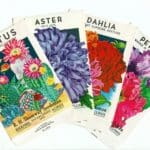
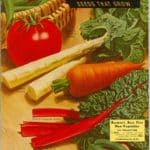
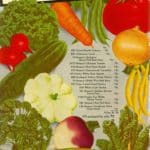
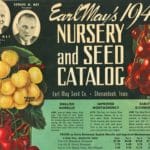
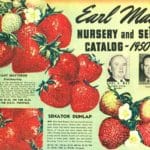
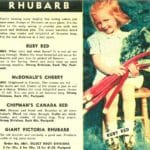
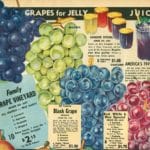
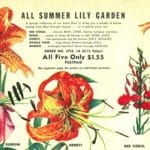


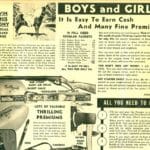

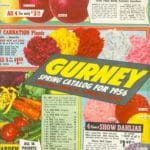

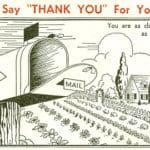
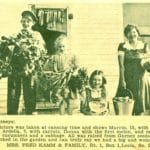

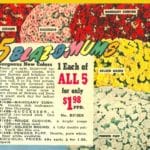
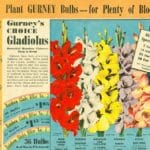
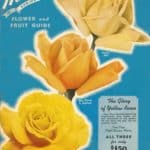



Related posts: